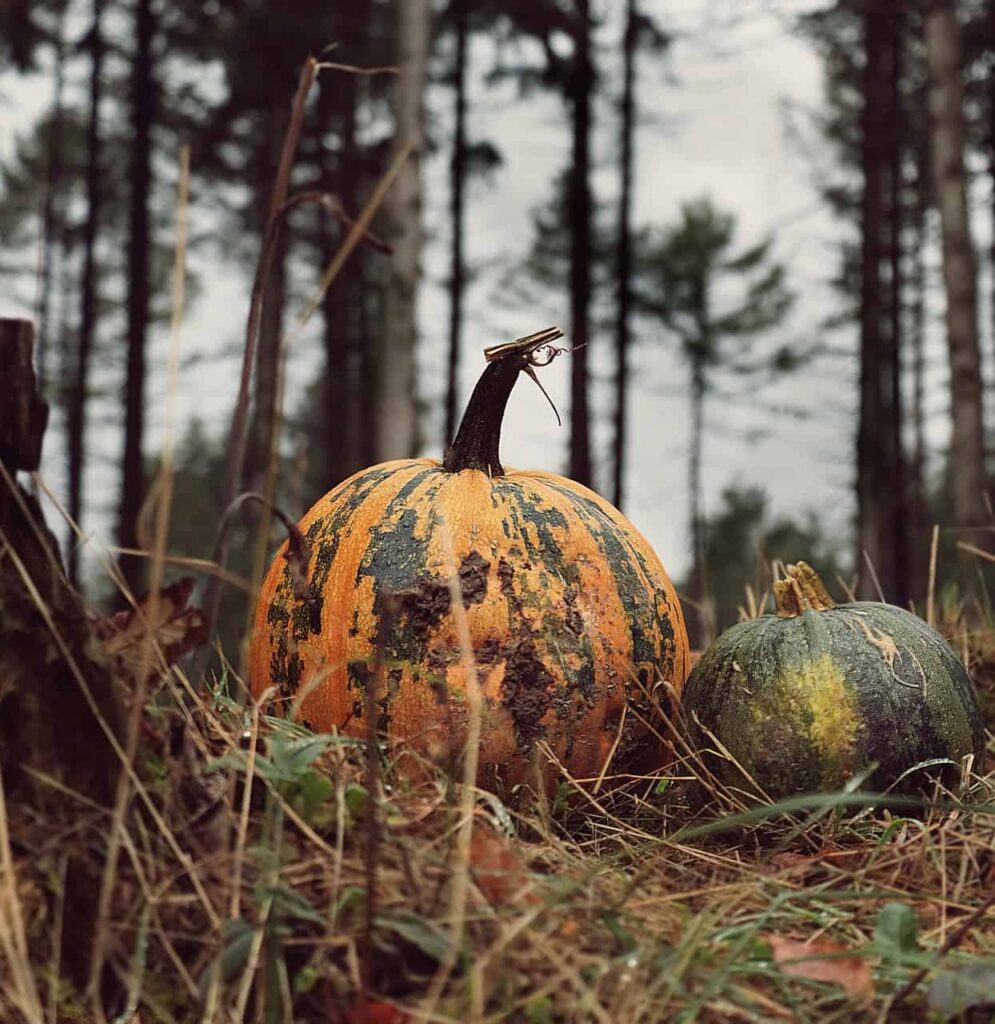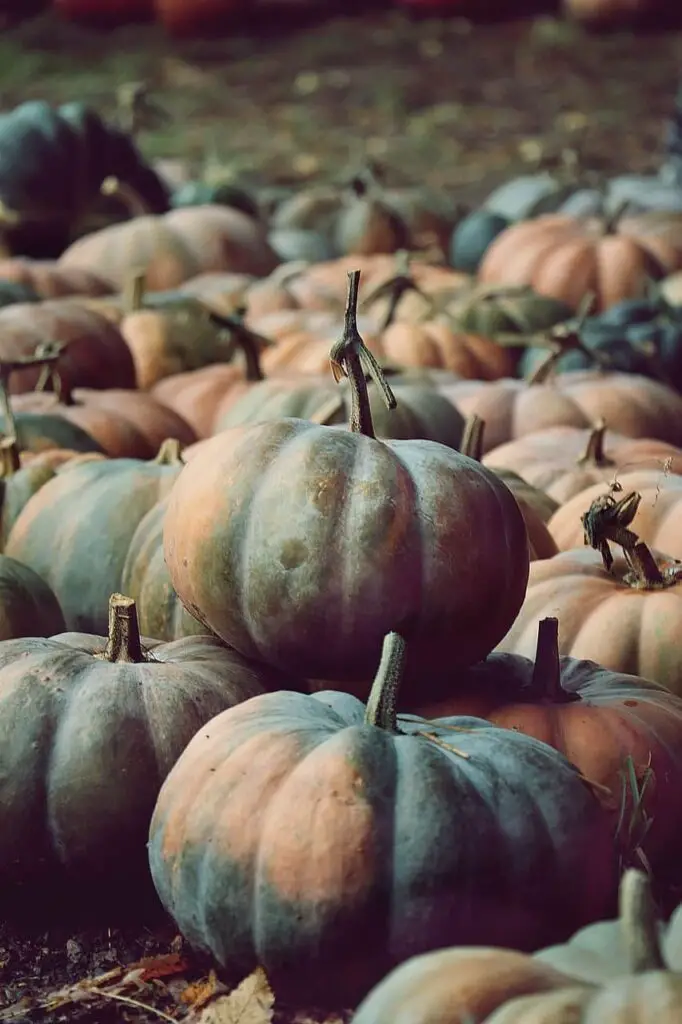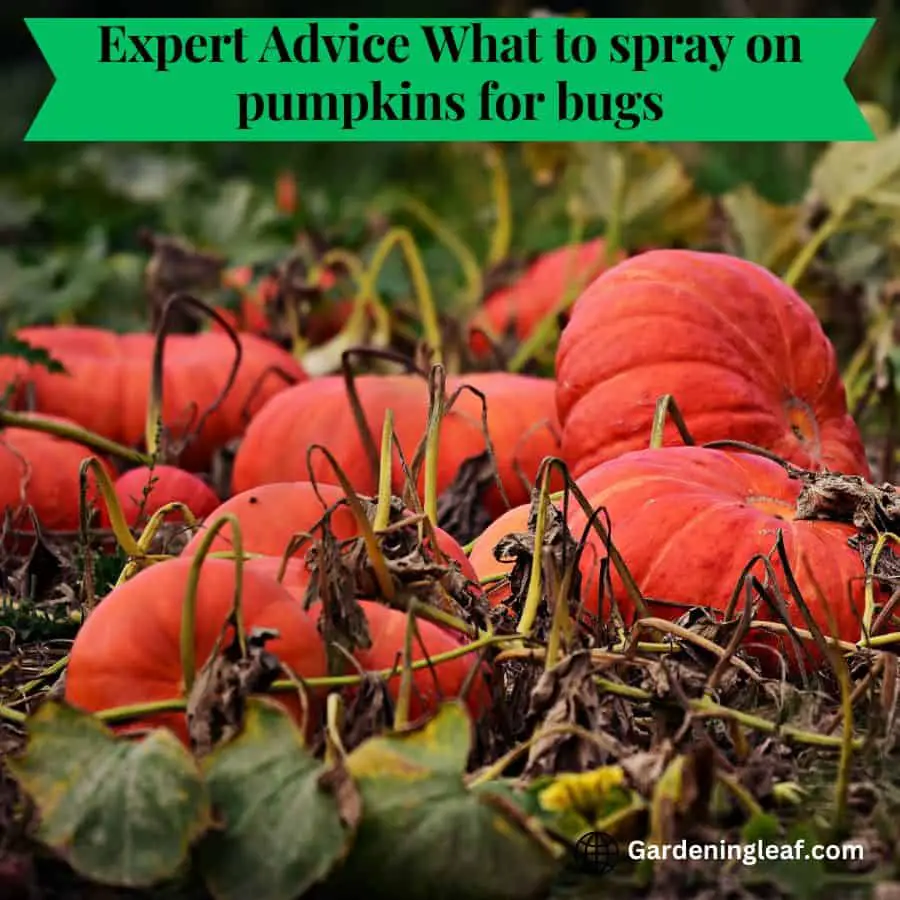Pumpkins are a staple of fall decor. But unfortunately, they can also attract unwelcome visitors in the form of bugs. People struggle to eliminate insects and spiders; sometimes, the problem worsens.
Pumpkin bugs are a common problem during the fall season, and the best way to get rid of them is by using a bug spray. But the real problem is what to spray on pumpkins for bugs. Because there are different types of bug spray available in the market, it can be challenging to know which one is safe and effective for use on pumpkins. We’ll discuss some practical tips for eliminating bugs in this article.
What are some of the most common pumpkin pests?

Beetles: Pumpkins are most infested with cucumber beetle. There are small insects that feed on sap from cucurbit plants. Cucumber beetles can grow up to 8 mm long, and their body shape is oval with well-developed wings. They have small eye spots in the front of their heads.
They lay eggs that hatch into small white or yellow grubs which feed on plant roots, stems, and leaves. And fruit during summer months at night, causing damage by boring holes through them.
Aphids: These tiny bugs consume sap from cucurbit plants. It’s causing them to grow smaller and produce less fruit. Aphids can be eliminated by handpicking or using garden spray insecticides.
Squash bugs: These small, black, green pests live on squash plants. They spread pumpkin bug infestations. Treatment with a pesticide will control the pest but is not always necessary.
Mites: These minuscule organisms consume the sap of plants and have the potential to induce yellowing or detachment of leaves.
Caterpillars: Pumpkin caterpillars can eat large holes in aerial fruit structures (like leaves and vines). Causing them to fall off early and produce less sweet vegetables
Vine Borers:- A beetle lives in the pumpkin plant, and they will not eat the fruit. The vine borer larvae tunnel into the pumpkin from the roots and make large holes. Leading to stunted or even dead plants. It can destroy pumpkins if you do not remove them timely.
Read More: Getting The Timing Right: Best Time To Spray Fungicide
What to do if your pumpkin plant attracts my bugs
Whether they are squash bugs, vine borers, or Beetles. It is important to spray your pumpkin plant with an insecticide before the bug populations become unmanageable.
- Cut any pumpkin leaves that are damaged.
- Research insecticides compatible with pumpkin plants.
- Apply insecticide early morning or shortly after dusk when bug populations are lowest.
- It allows treated plants to dry completely before storing. This will help prevent pest problems from recurring next season.
- Apply insecticide again in late fall or early winter if pest populations become a problem again.

Read More : – How Often To Water Pumpkins: Essential Tips For Success
What to spray on pumpkins for bugs
Natural Pesticides for Pumpkins
Suppose you prefer to take an organic approach to pest control. Several natural remedies can deter bugs from infesting your pumpkins. These natural pesticides for pumpkins offer friendly alternatives to synthetic insecticides.
Neem Oil
Neem oil is an effective natural remedy for controlling pests and insects attacking pumpkins. It contains compounds that repel or disrupt the growth and reproduction of insects, including beetles, aphids, and squash bugs.
Dilute neem oil spray (1 part oil to 100 parts water) before using it on plants. Wait 10 minutes for the oil to seep into the plant’s tissues before watering, and repeat as necessary.
Garlic Spray
Garlic spray, made by blending garlic cloves and water. It can be an effective deterrent against various pests. Its strong odor repels bugs while leaving your pumpkin plants unharmed.
Insecticidal Soap
Insecticidal soap, a solution of mild soap and water, is another organic option for pest control. It suffocates soft-bodied insects like aphids and mites, reducing their population.
Diatomaceous Earth (DE)
Diatomaceous Earth (DE) powdery substance is an effective method for controlling pests. it crushes their exoskeletons, leading to their death or paralysis. It can be easily applied by sprinkling it on plants before dawn or during the evening when bugs are less active and not feeding. This method is safe for humans and pets as it does not involve harmful chemicals.
Bacillus thuringiensis (Bt)
Bacillus thuringiensis (Bt) is a naturally occurring soil bacterium widely used as a biological insecticide. It is known for its effectiveness against certain types of insect larvae, particularly those of moths and butterflies. Bt-based products are used in organic gardening and integrated pest management (IPM) programs.
Read More: – How To Get Rid Of Spider Mites During Flowering (The Easy Way)
Organic Sprays to Safeguard Your Pumpkins
When it comes to What to Spray on Pumpkins for Bugs and you want organic sprays formulated for pumpkin protection, you have several options available. These sprays are manufactured with natural components. So your plants and the environment won’t be harmed by their use.
Pyrethrin-Based Sprays
Pyrethrin-based sprays are made from chrysanthemum flowers. It works effectively with a wide range of pumpkin pests. These sprays kill pests instantly and prevent new infestations. Pyrethrin-based sprays are eco-friendly and safe for people and pets. These are natural insecticides.
Spinosad Sprays
Spinosad sprays are derived from naturally occurring soil bacteria. It is used for aromatherapy and is another excellent choice for organic pumpkin pest control. They target a variety of insects, including squash bugs and cucumber beetles.
Essential Oil Sprays
Peppermint, rosemary, and clove oil effectively create homemade sprays that keep pests away. All you need to do is dilute a few drops of the essential oil of your choice in water and apply it to your pumpkin plants. This natural method is safe and chemical-free.
Commercial Insecticide for Pumpkins Protection
If natural remedies aren’t providing enough control, you may consider using commercial insecticides.
Carbaryl-Based Insecticides
Carbaryl-based insecticides are broad-spectrum pesticides. It can effectively control many pumpkin pests. They kill and protect quickly. They may be poisonous to beneficial insects, so use them cautiously.
Sevin is a popular brand name for carbaryl-based insecticides. It comes in various formulations, including dust, granules, and liquid sprays.
Permethrin-Based Insecticides
Permethrin is a potent insecticide that effectively controls various pests such as mosquitoes, ticks, fleas, and insects. Being a synthetic pyrethroid, it disrupts the nervous system of these pests, causing paralysis and death. Despite its potent action, permethrin is relatively safe for humans and pets.
Bifenthrin-Based Insecticides
Bifenthrin is another synthetic pyrethroid insecticide that controls many pests, including ants, termites, spiders, and insects. It has a longer residual activity than permethrin, which means it continues to be effective for a long time after its application.
How to identify pumpkins for bugs and treat them?
- Look for small black bugs with wings on a white background. The adults look similar but have brown wings instead of black ones.
- Next, check out the plant’s foliage: Are any beetle larvae or aphid colonies present? Aphids can cause severe damage to pumpkins, so it is worth treating them early if you see them.
- If the plant has been infested by other bugs, like moths or squash vine borers, you won’t see pumpkin bug nymphs on it. Be sure to treat these pests as well!
- Look for the pumpkin bug’s characteristic insect features. Such as a yellow or orange body, long antennae, and small wings compared to its body size. You can also look for signs of infestation in your garden – like bugs crawling on the pumpkin or leaves falling off.
- Look at the fruit surface for any signs of worms, mites, or other pests. If there are any issues, cut off the affected pumpkin section and toss it.
- Check for injuries on the stem or leaves. If there is damage, remove these parts (again, if necessary) and dispose of them.
- Inspect the inside of the pumpkin for eggs. If you find any Egg Layers (young feeder insects), take appropriate measures to get rid of them before they hatch into destructive adults.
Preventive Measures for Future Harvests
Controlling pests during the current season is important. Implementing preventive measures can ensure healthier pumpkin plants.

Crop Rotation
To interrupt the life cycles of pests and minimize their accumulation in the soil, it is recommended to rotate your pumpkin crops annually.
Companion Planting
Add companion plants like marigolds, nasturtiums, and mint to your pumpkin patch. These plants can ward off pests and draw in predatory insects that can help protect pumpkin crops.
Proper Garden Hygiene
To prevent pests from taking refuge, it is important to maintain a clean and debris-free garden.. Remove weeds and fallen leaves to minimize pest populations.
Read More :- Easy Guide To Using Neem Oil For Garden Pest And Disease Control
Are the organic sprays safe for edible pumpkins?
Organic sprays such as neem oil, garlic spray, and insecticidal soap are safe for edible pumpkins. These sprays are made from natural ingredients and do not contain harmful chemicals.
How repeatedly should I apply the organic sprays?
The frequency of application depends on the type of organic spray you use and the severity of the pest problem. Use the product label’s directions. Monitor your pumpkin plant. To decide if more treatments are needed. Generally, sprays are recommended every seven to fourteen days for best results.
Are commercial insecticides harmful to the environment?
Commercial insecticides can have an impact on the environment, especially beneficial insects. It’s using them judiciously, following the instructions, and considering alternative options first.
When should I apply insecticides to my pumpkin plants?
To ensure the maximum efficacy and safety of bees and other beneficial insects. It is recommended to apply insecticides in the early morning or late evening when the activity of insects is lower.
Read More:- How To Get Rid Of Purslane In The Garden – 6 Easy Way
Conclusion
Hopefully, this article satisfies your query about What to spray on pumpkins for bugs. It’s always important to keep a close watch on your plants, and if you notice any abnormalities or pests, use a dish soap spray to get rid of them. Additionally, implementing preventive measures for future seasons will contribute to the long-term health of your pumpkin plants.
Source:- https://abctermite-pest.com/do-pumpkins-attract-pests/

